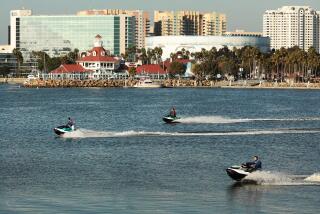Rent Is Too Low for Genteel Marina Tenant, Some Say : Yacht Club, Critics Spar Over Lease
- Share via
It was cocktail hour at the Long Beach Yacht Club.
Commodore David Berg stood on the club balcony and, drink in hand, surveyed the thicket of white masts that line the Long Beach Marina.
As waitresses took orders and yachtsmen grazed on hors d’oeuvres, Berg recalled what the marina looked like more than 25 years ago, when the club was built.
“Marshland . . . mud flats,” Berg said. Without the club, he added, “the marina wouldn’t have prospered as it has.”
Many city officials agree with Berg, saying that the club, with its sponsorship of prestigious events such as the annual Congressional Cup match racing series, has greatly enhanced the image of Long Beach.
Some of those officials, however, are also saying that the club is taking the city for a ride.
Lease Called Sweetheart Deal
The officials complain that the private club has a sweetheart lease that enables it to monopolize valuable land that belongs to taxpayers. City officials also are questioning whether the club is providing any services for the majority of city residents.
“The Yacht Club is subsidized by virtue of the cheap land that is virtually given to the Yacht Club for free,” Mayor Ernie Kell said at a council meeting earlier this month.
In an interview last week, Kell said the club should reciprocate the city’s generosity by contributing money to the city’s homeless. Berg declined comment on the mayor’s suggestion.
Under a contract originally signed in 1960 and amended in 1970, the club pays the city $476 a month for 1.6 acres of prime waterfront land. The rent can be reviewed every five years, but rent increases are limited to increases in the consumer price index. The lease expires in January, 2020.
The yacht club lease became an issue earlier this month, after the club sought permission to expand its bar and dining room. The city lease requires that the club submit all proposed improvements to the City Council for approval.
The city official who tried to negotiate an increase in fees in return for approval of expansion was Carolyn S. Sutter, general manager of the city Tidelands Agency. She said in an interview last week that the club should be paying the city $70,000 annually, based on area market values. The club’s current monthly rent amounts to $5,712 per year.
New Negotiations Rejected
The club’s board of directors, however, refused to renegotiate with the city. The city’s attorneys agreed that the city cannot use the expansion request as a condition for getting the club to modify its lease, said Assistant City Atty. Robert Shannon.
The expansion will increase the size of the Yacht Club’s restaurant, bar and dining facilities by 1,400 square feet from the current 19,579 square feet.
The City Council approved the expansion in a 7-1 vote Aug. 19, over the objections of Sutter and City Manager John E. Dever. Dever and Sutter recommended denying the requested expansion on grounds that it does not promote the primary purpose of the lease: to increase the popularity of yachting.
A lawyer representing the yacht club, however, said the expansion would help the club accommodate increased demand for club services during yachting events. The lawyer, Konstantine P. George, a club member, also defended the club’s lease.
“In 20/20 hindsight, it may appear that the lease is not as advantageous to the city as it might be,” George said.
Facility Deeded to City
George, however, said that club members took a risk when they decided to commit $200,000 of their own money to build the club, which has since been deeded to the city.
“The club entered into a long-term lease and assumed a substantial risk. They made a substantial investment and they are therefore entitled to the benefit of the bargain,” George said.
“I think the yacht club is a substantial benefit to the community in that they provide an atmosphere in the city which is part of a well-rounded recreational program for its citizens,” George said.
Berg agreed: “Because of the name Long Beach Yacht Club, everything the club does affects Long Beach positively as a truly international city.”
The council’s decision to approve the bar and dining room expansion prompted one council member, Warren Harwood, to complain that the approval was rushed through to accommodate the club’s “influential” members.
Kell denied it, saying that the approval was granted because the yacht club “does a lot of good in the community.”
In an interview, Harwood recalled that before the Long Beach and Alamitos Bay yacht clubs were built in Alamitos Bay, the area was accessible to all city youths.
(The neighboring Alamitos Bay Yacht Club has a similar lease with the city for 2.5 acres. It pays a monthly rent of $777, or $9,324 a year. That lease expires in 2022.)
Once Used by Youngsters
“The fancy marinas and gates that require keys and cards used to be places where youngsters fished and enjoyed water recreation,” said Harwood, who represents North Long Beach and cast the only vote against the expansion.
“I think people in the community have a right to expect a return from these public facilities,” Harwood said. “I’m just not aware that the club is extending themselves in any significant manner to the people of North Long Beach.”
Other council members agree.
“I’m not hostile to the yacht club,” said Councilman Tom Clark, who voted for the expansion. Clark added, however, that the club needs “more of a community outreach program and a public relations program to make the community feel the use of choice public land is being reciprocated.”
Like Harwood, Clark suggested that the Yacht Club should provide boating classes for disadvantaged city youth. Berg, however, said that such classes are provided by the Alamitos Bay Yacht Club. He said his club does not wish to compete with a program offered by a “fellow yacht club.”
Berg added that the club does provide boating classes for the children of its members. The club also sponsors the Douglas Cup, an intercollegiate competition, and allows the Coast Guard Auxiliary to use its facilities.
Share of Sales
City Auditor Robert Fronke says the yacht club’s bar and restaurant are competing with area restaurants that pay the city a percentage of their food and beverage sales. Therefore, Fronke says, the city should require the club to pay the city a percentage of its food and bar sales.
According to Fronke, the neighboring Rusty Pelican Restaurant pays the city $120,000 annually to lease 0.2 acres while the nearby Chart House restaurant pays the city $90,000 per year to lease approximately one-quarter acre.
Although club officials denied that their 80-seat restaurant competes with private businesses, at least one restaurateur disagreed.
Joe Pierce, the Rusty Pelican’s manager, said he believes that the Long Beach Yacht Club hurts his lunch trade by drawing “wealthy people” that are club members. He called the Yacht Club lease an “unbelieveable deal.”
Other Southern California yacht clubs that pay cities or counties rents based on a percentage of food and beverage sales include the Santa Monica Yacht Club in Marina del Rey, the Pacific Corinthian Yacht Club of Oxnard, the Dana West Yacht Club of Dana Point and the Capistrano Bay Yacht Club of Capistrano Beach, according to a city survey.
Middle-Class Membership
The Long Beach Yacht Club has 900 regular members, the majority of whom are middle class, said Berg, 47, a special projects director for Mobilecomm Inc. of Los Angeles.
Berg said the club does not have a discriminatory policy that would exclude any group. He said there are Jewish members, but there are no black members “at the present time.”
Qualifications for the club include a “love of the sea and yachting,” as well as boating skills and a “yachting background.”
To become a member, a person must be sponsored by a club member and receive a favorable recommendation of the board of directors. He would not disclose the organization’s annual membership fees.
According to a recent survey, Berg said, 80% of the club’s regular members live within 20 miles of the club
More to Read
Sign up for Essential California
The most important California stories and recommendations in your inbox every morning.
You may occasionally receive promotional content from the Los Angeles Times.










